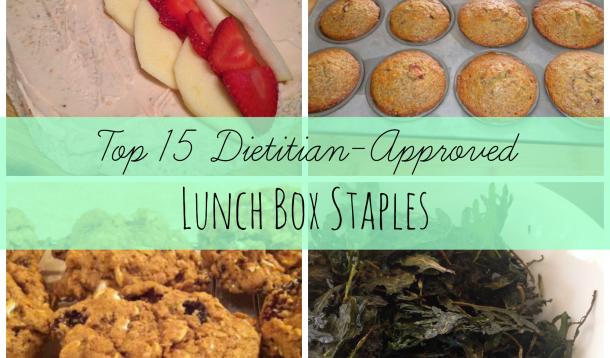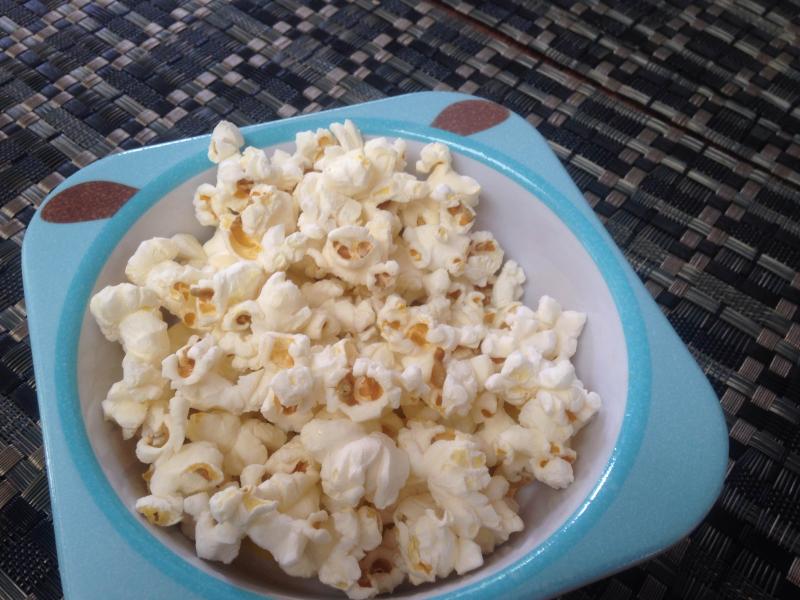
The first day of school is right around the corner, and many of us are faced with the seemingly daunting task of packing healthy lunches every day for our kids. Because this seems to be a common source of anxiety for moms everywhere, I thought I'd create a list of kid-friendly lunch-box staples that have my dietitian's stamp of approval.
But first, here are five tips that will help you feel a little less overwhelmed and a little more prepared for making healthy lunches that you kids will actually eat:
Take the pressure off of yourself and know that you can easily create a yummy and healthy lunch that your kids will eat without it having to be fancy and pin-able.
It's a great idea to sit down with you kids and create a big list of ideas for school lunches. If you're not a meal planner, make it much simpler by just posting a list of ideas in your kitchen somewhere as a reference when you're looking for ideas. Involving your kids is key, as they will feel a sense of control over what's going into their lunches and will make it much more likely that they'll actually it! Alexandria Durrell, YMC's Irritated By Allergies blogger has created a stellar lunchbox idea list (88 ideas in total!) over on her blog that I would highly recommend you check out.
Refer to your list weekly to make sure that your fridge and pantry are stocked. Write a list of what you need and head to the store on the weekend so that you're not panicking come Monday morning. Go one step further and rinse, and cut up veggies and fruits for quick and easy packing.
Establish a routine that is realistic for you and your family. I know that for us, weekly meal planning is just not going to happen--not at this point anyways--so having our handy list of ideas to choose from, always having our kitchen stocked with the foods from our list and having pre-cut vegetables and fruit that we can throw into our lunch box works great. We also always pack our lunches the night before, because we seem to always be running behind in the morning. Regardless, it's important that your routine fits with your schedule and life and that you can stick to it.
What I tend to see when it comes to school lunches is that they are heavy on the carbs (think fruit snacks, crackers, cookies, breads, treats, juice) and light on more nutritious and filling options containing more protein and fat (meat, fish, eggs, dairy, beans, seeds and lentils, hummus, soy) and fibre (fresh fruits and vegetables, whole grains, seeds, beans and lentils). Don't get me wrong, carbohydrates are an important source of fuel for our kids, especially if they are athletes and are training before and/or after school. However, foods rich in protein, fat, and fibre are also important for many reasons, including establishing fullness, concentrating during school and receiving important nutrients for overall health, growth and development.
Here is my list of top 15 lunchbox staples:
We often make popcorn in the evening as a snack, so I always make extra to pack in our lunch the following day. Popcorn is high in fibre and fun to eat, making it a fantastic and healthy addition to your child's lunch.

Eggs are one of the most nutritious foods on the planet. They're rich in protein, iron, and many vitamins and minerals that are essential to your child's health. We boil several eggs at the start of the week and use them for lunches on they're own, or make them into egg salad for sandwiches or as a dip for veggies or crackers.
Whether it's store bought or homemade, hummus is a great dip for veggies because it contains both protein and fibre. It also adds some flavour to raw veggies, which makes it more likely that they'll munch on them! We pre-cut garden carrots, mini-cucumbers, bell peppers and celery to pair with this tasty dip. Find a small (1/4 cup of so) container to store the hummus in.
I find that we use tortilla wraps much more often than plain bread, because they tend to be less messy (and soggy, after sitting in a lunch kit), and more fun to eat. I make the standard meat, cheese and lettuce wraps often, or I'll get a bit more creative and pair cream cheese with various fruits in a wrap (I like to sprinkle chia seeds or hemp hearts on top), or make a hummus and veggie wrap. Some kids like their wraps cut into "sushi" pieces and some kids like to eat them as a roll.
Greek yogurt is a great protein and calcium-rich option for lunches and snacks. Greek yogurt contains double the amount of protein than regular yogurt, which adds to the fullness factor of your child's lunch. It also has a much creamier texture. Plain is the healthiest way to go (I usually add a bit of honey or maple syrup), or if buying individual flavoured yogurts (which I often do), I don't buy the fruit on the bottom varieties (these tend to be higher in sugar) and stick to ones that have less than 10 grams of carbohydrate per 100 g serving.
Cottage cheese is high in protein, which helps to keep your kids fuller longer, and when paired with yogurt or fruit makes a yummy sweet and salty combination. You can purchase individual-sized cottage cheese containers (with or without fruit), or just use your own containers.
I always keep a supply of frozen homemade muffins in the house for lunches and snacks. My kids love them, they're easy to make and they're healthy. I throw them into the lunch kit frozen so that they keep the rest of the lunch items cool all morning. My favourite two nut-free recipes are these four bowl banana bran muffins and these pumpkin spice muffins (do not use the optional nuts).

I love cheese strings, baby bell cheeses, or laughing cow cheeses because they are individually packaged and I can throw them into my child's lunch kit with no fuss. Cheese is a great source of protein and calcium, and most kids love it.
There aren't too many packaged food items that I'll buy for my kids, but I will purchase unsweetened apple (or other fruit) sauces for snacks and lunches. Even though fresh or frozen are the best options, unsweetened fruit sauce adds some variety and fun to your child's lunch kit.
Crackers are always a favourite when it comes to school lunches and after school snacks. Paired with cheese, hummus, or meat, and fruits or vegetables, they can be a healthy option. The key is to find a whole grain cracker without a lot of additives, preservative, salt, or trans fat. Look for the term "whole grain" as the first ingredient on the ingredients list (and be sure that it's not a lengthy ingredients list) and you're on the right track.

Fresh fruit is an easy, nutritious and delicious addition to any school lunch. Frozen fruits are great too when added to yogurt parfaits, however on their own, they can be a bit messy. Dried fruit is fine in moderation, but if consumed too often and it too large of a quantity can pack a punch in the sugar department.
When you layer Greek yogurt with any fresh fruit and homemade granola (or healthier nut-free store-bought option), you've got a tasty and healthy lunch that most kids love. Let your child choose the type of fruit and ask how they would like it layered (better yet, get your child to make it!). Add chia seeds, flax seeds or hemp hearts for added fibre and healthy fat.
As a healthier alternative to store-bought granola bars, which are often full of sugar, additives, preservatives, and trans fats (not to mention, often contain nuts), homemade, nut-free granola bars—if made with nutritious ingredients—are a great option for school lunches. Nicole MacPherson, one of YMC's fabulous food bloggers, has an amazing recipe for school-safe, nut-free granola bars that you should check out.
These healthy cookies are a great way to add a bit of sweetness to your child's lunch without using processed, packaged treat foods. I use large-flaked oats as well as stone-ground whole grain flower in this recipe, which adds lots of fibre and staying power when compared to other cookie recipes.

Veggie chips make for a great appetizer before supper, or snack at a party, but they also make a fun addition to your child's lunch. Kale chips are always a hit, but other vegetables such as yams, parsnips, sweet potatoes, beets, and zucchini can also be made into chips! Check out the recipe for these delicious baked dill pickle zucchini chips. Make sure to pack the chips in a dry air-tight container.
Here are 7 Ways To Get Your Kids To Eat Their School Lunches as well as 7 Kid-Friendly And Healthy After School Snacks.
I post daily nutrition tips, recipes and resources for Moms and kids over on my facebook page, so please feel free to check it out!
You can learn even more ways to get organized and transition from summer to school on our Back-To-School 2014 page.